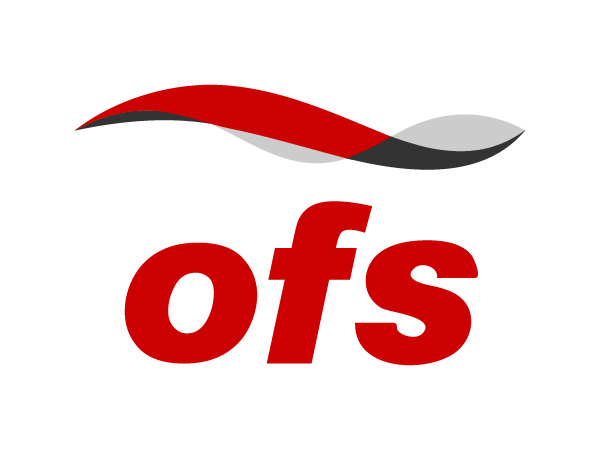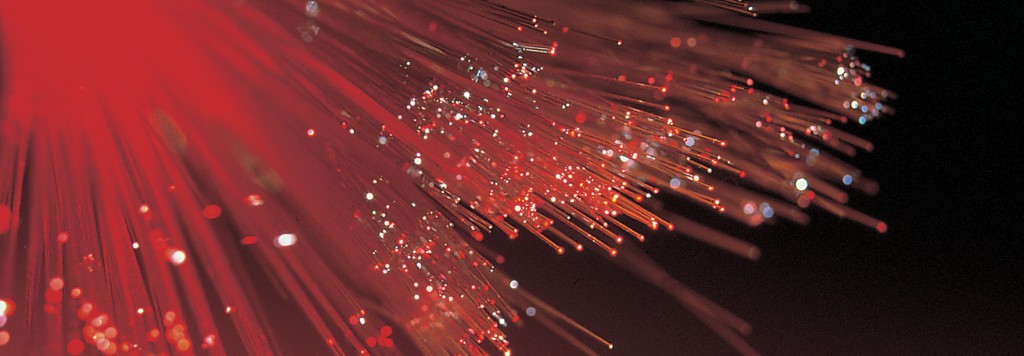 OFS announced the launch of its LaserWave® FLEX WideBand Multimode Fiber at the BICSI 2015 Fall Conference in Orlando this week. Developed to enable next-generation short wavelength division multiplexing (SWDM) applications, this new wideband multimode fiber also meets the demanding requirements of today’s OM4 applications.
OFS announced the launch of its LaserWave® FLEX WideBand Multimode Fiber at the BICSI 2015 Fall Conference in Orlando this week. Developed to enable next-generation short wavelength division multiplexing (SWDM) applications, this new wideband multimode fiber also meets the demanding requirements of today’s OM4 applications.
Unlike conventional multimode fiber, which carries transmission at the single 850 nm wavelength, LaserWave FLEX WideBand Fiber supports traffic over a range of wavelengths from 850 nm to 950 nm. This capability allows multiple lanes of traffic over the same strand of fiber, significantly improving the bandwidth capacity of multimode fiber while maintaining its cost advantages for short-distance applications (up to 300 meters or more). In this way, LaserWave FLEX WideBand Fiber can support four wavelength 100 Gb/s applications, while providing bandwidth for tomorrow’s 400 Gb/s and higher speeds.
Building on the history of OFS’ bend-optimized LaserWave FLEX 550 (OM4) Fiber, this new wideband multimode fiber is also backward compatible with existing OM4 networks and applications, and complies with OM4 fiber requirements.
To learn more about LaserWave FLEX WideBand Multimode Fiber, please use the links below.
Press Release
FAQ Sheet
Data Sheet
White Paper
 OFS is pleased to launch the InvisiLight Multiple Dwelling Unit (MDU) Solution that offers virtually invisible and faster fiber routing inside residential and business MDUs. This new solution combines with our current InvisiLight Indoor Living Unit (ILU) Solution to provide a complete in-building, fiber-to-the-home (FTTH) and fiber-to-the-business (FTTB) system.
OFS is pleased to launch the InvisiLight Multiple Dwelling Unit (MDU) Solution that offers virtually invisible and faster fiber routing inside residential and business MDUs. This new solution combines with our current InvisiLight Indoor Living Unit (ILU) Solution to provide a complete in-building, fiber-to-the-home (FTTH) and fiber-to-the-business (FTTB) system.
Using this solution, service providers can help accelerate the adoption of fiber optic services by offering residents and tenants faster, lower cost and virtually invisible installation. And these benefits, in turn, can result in higher subscriber acceptance and take rates, greater profitability and faster times to revenue for service providers.
To view the InvisiLight MDU Solution and other leading-edge OFS products, visit booth # 513 at the OSP Expo 2015 in Denver, Colorado, September 2-3. And to learn more about this exciting product, please use any of the links below:
Press Release
Video
Broadband Communities magazine article
Brochure
Data Sheet

The Fiber to the Home (FTTH) Council Americas recently released a white paper finding that access to optical fiber can help increase a home’s value by up to 3.1 percent. In this study, the authors researched the relationship between fiber-delivered Internet services and housing prices. Based on their analysis, the increase to the value of a typical home ($5,437) is roughly equal to the addition of a half bathroom or fireplace to the home.
OFS has been an active member of the FTTH Council since its founding in 2001.
To read the full story, please visit http://www.ftthcouncil.org/blog/study-shows-home-values-up-3.1-with-access-to-fiber

EuroWire, an international magazine covering the wire and cable industries, has featured an OFS white paper entitled “Long-Term Cable Reliability Design Criteria.”
In this paper, Dave Mazzarese, Mike Kinard and Phil Konstadinidis investigate the current requirements for allowable axial load on fiber optic cables, with a focus on overhead cables. Their findings suggest that the current criterion found in many fiber optic cable standards may be too optimistic.
To access the full article, please use this link.
 OFS released a white paper on the new FITEL® NINJA™ NJ001 handheld fusion splicer at the FTTH Connect Conference in Anaheim this week. Specifically designed for Fiber-to-the-Home (FTTH) applications. the NINJA features the industry’s first detachable V-groove that allows technicians to easily remove and clean that part.
OFS released a white paper on the new FITEL® NINJA™ NJ001 handheld fusion splicer at the FTTH Connect Conference in Anaheim this week. Specifically designed for Fiber-to-the-Home (FTTH) applications. the NINJA features the industry’s first detachable V-groove that allows technicians to easily remove and clean that part.
With fusion splice-on connectors gaining acceptance as a way to field terminate cables, the NINJA is compatible with fusion splice-on field installable connectors from a wide variety of manufacturers. In addition, while the NINJA design is compact and low profile, its large battery capacity allows 100 splicing and heating cycles in one charge. Finaly, FTTH drop cables are often stiff. Less powerful splicer motors can require the technician to perform more cable preparation to offset the motor weakness. The NINJA offers powerful fiber propulsion motors to complete splices with even very rigid drop cables.
According to Mark Boxer, Applications Engineering Manager and author of the white paper, dirty V-grooves are a source of error and also the number one reason splicers are submitted for repair. In fact, OFS data indicates that approximately 60-70% of splicer repair occurrences are due primarily to dirty V-grooves.
For more information and to access this new white paper, please go HERE.
 Today, OFS introduced the newest member of its growing microcable product family at the FTTH Connect Show in Anaheim, CA.
Today, OFS introduced the newest member of its growing microcable product family at the FTTH Connect Show in Anaheim, CA.
Building on the company’s expertise in microcable technology, the MiDia® FX Cable is specifically designed for excellent air-blown installation performance using microducts. This new cable can help make fiber optic cable deployment faster and less costly, especially in locations where space is at a premium.
While offering the smallest cable outer diameter in OFS’ North American microcable portfolio, MiDia FX Cable also provides excellent mechanical and environmental protection in compliance with Telecordia GR-20.
“With their continued focus on reducing costs, our North American customers can now capitalize on the installation and cost benefits of MiDia FX Cable,” said Pierre Marty, Executive Vice President Sales and Marketing for OFS.
Available with 12 to 144 fibers from a full range of OFS application-specific fibers, MiDia FX Cable is the latest innovation in OFS’ extensive line of OSP cable products, building upon the company’s expertise in the development and expansion of microcable technology.
To learn more about MiDia FX Cable, please go HERE.

Enterprise networks and data centers around the world are increasingly installing bend-insensitive OM3 and OM4 Multimode Fibers. These fibers interoperate well with the embedded base of multimode fiber. However, if a link is not characterized properly, misleading test results can occur.
In BICSI’s ICT Today magazine, Dave Mazzarese describes how to properly measure the channel insertion loss of a multimode optical fiber link and why using the prescribed method is important.
 OFS recently helped to deploy a turnkey Fiber-to-the-Home (FTTH) network in the City of Sandy, Oregon. This new network brings 1 GB/s broadband service to approximately 3,500 residents via SandyNet, the internet service provider (ISP) owned by the community and operated by the city since 2003. Sandy is only one of many communities across the nation that have deployed their own high-speed FTTH network. Many of these communities lack a service provider, have limited broadband options or have been largely ignored in the nationwide push for gigabit service. (more…)
OFS recently helped to deploy a turnkey Fiber-to-the-Home (FTTH) network in the City of Sandy, Oregon. This new network brings 1 GB/s broadband service to approximately 3,500 residents via SandyNet, the internet service provider (ISP) owned by the community and operated by the city since 2003. Sandy is only one of many communities across the nation that have deployed their own high-speed FTTH network. Many of these communities lack a service provider, have limited broadband options or have been largely ignored in the nationwide push for gigabit service. (more…)

Network owners are increasingly converting their data center and enterprise telecommunication/data communication systems from copper cabling to optical fiber. Because these applications have shorter overall spans and often use connectors instead of splices, they differ from what is typically seen in long-haul, metropolitan and access deployments.
As the use of optical fiber continues to grow in these networks, Technical Manager Dave Mazzarese has identified five key things that users should know about selecting a fiber for in-building applications. To learn more and access Dave’s complete analysis, please go here.

The employees of OFS recently reflected on our role in successfully deploying a massive network that makes Maryland the most “wired and connected” state in the nation 2015.
In this project, nine Maryland governmental jurisdictions joined forces to form The One Maryland Inter-County Broadband Network (ICBN). ICBN then partnered with the State of Maryland to achieve the goal of providing affordable and accessible high-speed broadband access to community institutions, businesses and residents across the state. (more…)
Page 6 of 7« First«...34567»
 OFS announced the launch of its LaserWave® FLEX WideBand Multimode Fiber at the BICSI 2015 Fall Conference in Orlando this week. Developed to enable next-generation short wavelength division multiplexing (SWDM) applications, this new wideband multimode fiber also meets the demanding requirements of today’s OM4 applications.
OFS announced the launch of its LaserWave® FLEX WideBand Multimode Fiber at the BICSI 2015 Fall Conference in Orlando this week. Developed to enable next-generation short wavelength division multiplexing (SWDM) applications, this new wideband multimode fiber also meets the demanding requirements of today’s OM4 applications.

 OFS is pleased to launch the InvisiLight Multiple Dwelling Unit (MDU) Solution that offers virtually invisible and faster fiber routing inside residential and business MDUs. This new solution combines with our current InvisiLight Indoor Living Unit (ILU) Solution to provide a complete in-building, fiber-to-the-home (FTTH) and fiber-to-the-business (FTTB) system.
OFS is pleased to launch the InvisiLight Multiple Dwelling Unit (MDU) Solution that offers virtually invisible and faster fiber routing inside residential and business MDUs. This new solution combines with our current InvisiLight Indoor Living Unit (ILU) Solution to provide a complete in-building, fiber-to-the-home (FTTH) and fiber-to-the-business (FTTB) system.

 OFS released a white paper on the new FITEL® NINJA™ NJ001 handheld
OFS released a white paper on the new FITEL® NINJA™ NJ001 handheld  Today, OFS introduced the newest member of its growing microcable product family at the FTTH Connect Show in Anaheim, CA.
Today, OFS introduced the newest member of its growing microcable product family at the FTTH Connect Show in Anaheim, CA.
 OFS recently helped to deploy a turnkey
OFS recently helped to deploy a turnkey 
